Yarn Guide in Textile Industry: Types and Application
What is Yarn Guide?
A yarn guides is a device used in the textile industry to help guide yarn or thread through textile machinery. It is a small component mounted onto the equipment and guides the yarn through various stages of the manufacturing process. The yarn guide helps to ensure that the yarn is tensioned correctly and controlled, which helps to prevent breakages and other problems during the manufacturing process. There are various types of yarn guides in textile industry used, each designed for different applications and types of yarns, and they can be made from other materials such as metal, ceramic, or plastic.
In fabric manufacturing, these guide is a device used to guide yarn during the manufacturing process. These guide is essential to weaving machines, knitting machines, and other textile manufacturing equipment. The primary purpose of a yarn guide is to ensure that the yarn is fed smoothly and evenly through the manufacturing process. This is important because variations in the tension or placement of the yarn can lead to defects in the finished fabric.
Important of Yarn Guides
These equipment is an essential component of textile manufacturing equipment and plays a crucial role in ensuring the quality and consistency of the finished fabric. Here, are some of the reasons why the yarn guide is so essential:
1. Consistent tension:
These equipment helps to maintain a consistent tension in the yarn as it is fed through the manufacturing process. This is critical for producing a uniform fabric in texture and appearance.
2. Even feeding:
The guide helps to ensure that the yarn is provided evenly through the manufacturing process. This prevents uneven fabric density or pattern distortion.
3. Reduced waste:
When the yarn is fed evenly through manufacturing, there is less waste due to yarn breakage or snarls.
4. Increased productivity:
A well-designed guide can help to increase productivity by reducing downtime due to yarn breaks or other manufacturing issues.
5. Improved quality:
By maintaining consistent tension and even feeding, the guide helps to produce a high-quality fabric that meets the desired specifications.
6. Reduced machine wear and tear:
These equipment helps to protect the machine from excessive wear and tear. By guiding the yarn smoothly and evenly, the guide helps to prevent damage to the machine parts that come into contact with the yarn.
7. Flexibility:
A well-designed guide can accommodate a wide range of yarn types and sizes, allowing textile manufacturers to work with various fabrics and materials.
8. Precision:
The guide can be adjusted to provide precise tension and feeding, allowing textile manufacturers to achieve particular fabric characteristics, such as stretch, texture, or pattern.
9. Cost-effective:
By reducing waste, increasing productivity, and improving quality, these equipment helps to make textile manufacturing more cost-effective.
10. Improved worker safety:
Properly maintained guides can help to prevent accidents and injuries caused by yarn breaks or snarls, which can lead to entanglement, falls, or other hazards.
The component of yarn guide made from
Yarn guides are typically made from materials that are resistant to wear and tear, such as ceramic, hardened steel, or plastic. The choice of material depends on a range of factors, including the type of yarn being used, the speed of the manufacturing process, and the conditions under which the equipment operates. Ceramic yarn guides are commonly used in high-speed textile manufacturing processes, such as in producing synthetic fibres or fabrics. Ceramics is a hard and durable material that can withstand the high speeds and friction generated during manufacturing. Ceramic guides are also highly resistant to wear and tear, making them a good choice for long-lasting, high-performance applications.
Hardened steel yarn guides are also used in high-speed manufacturing processes, particularly for heavy-duty applications that require greater strength and durability. Steel guides are typically made from a type of hardened alloy steel that can withstand high temperatures and the rigours of continuous operation. Plastic yarn guides, such as cotton, wool, or other natural fibres, are commonly used in low-speed textile manufacturing processes. Plastic guides are lightweight, easy to manufacture, and relatively inexpensive, making them a popular choice for applications that require flexibility and adaptability.
Overall, the choice of material for a yarn guide depends on a range of factors, including the specific needs of the manufacturing process, the type of yarn being used, and the conditions under which the equipment operates.
Types of Yarn Guides
Basically, there are two types of guides used in textile industry specially in fabric manufacturing. They are:
- Type-A: Closed guides (A yarn end is required for threading)
- Type-B: open guides ( A yarn end is not required for threading)
1. Type-A: Closed Guides:
A closed guide is a type of yarn guide used in textile manufacturing equipment that helps to guide the thread through the manufacturing process. Unlike an open yarn guide with a gap or opening through which the yarn passes, a closed guide completely encloses the thread as it is fed through the guide. Closed guides are commonly used in high-speed textile manufacturing processes, such as in producing synthetic fibers or fabrics. They are often made from materials that are resistant to wear and tear, such as ceramics or hardened steel, to withstand the high speeds and friction generated during the manufacturing process.
Closed guides may classified into three. they are:
- Ceramic Insert Type Yarn Guide.
- Trumpet Type Guide.
- Bush Type Guide.
Ceramic Insert Type Yarn Guide:
Ceramic insert guides are a specific type of guide that is commonly used in high-speed textile manufacturing processes. They consist of a ceramic insert that is embedded into a metal or plastic holder. The ceramic insert provides a smooth, low-friction surface for the thread to pass over, which reduces the risk of damage to the thread and increases the speed and efficiency of the manufacturing process. Ceramic insert guides are highly durable and resistant to wear and tear, which makes them a popular choice for textile manufacturers.
The ceramic material is hard and durable, which allows it to withstand the high speeds and friction generated during the manufacturing process. The smooth surface of the ceramic insert also helps to reduce friction and eliminate the risk of snags or breaks in the yarn.
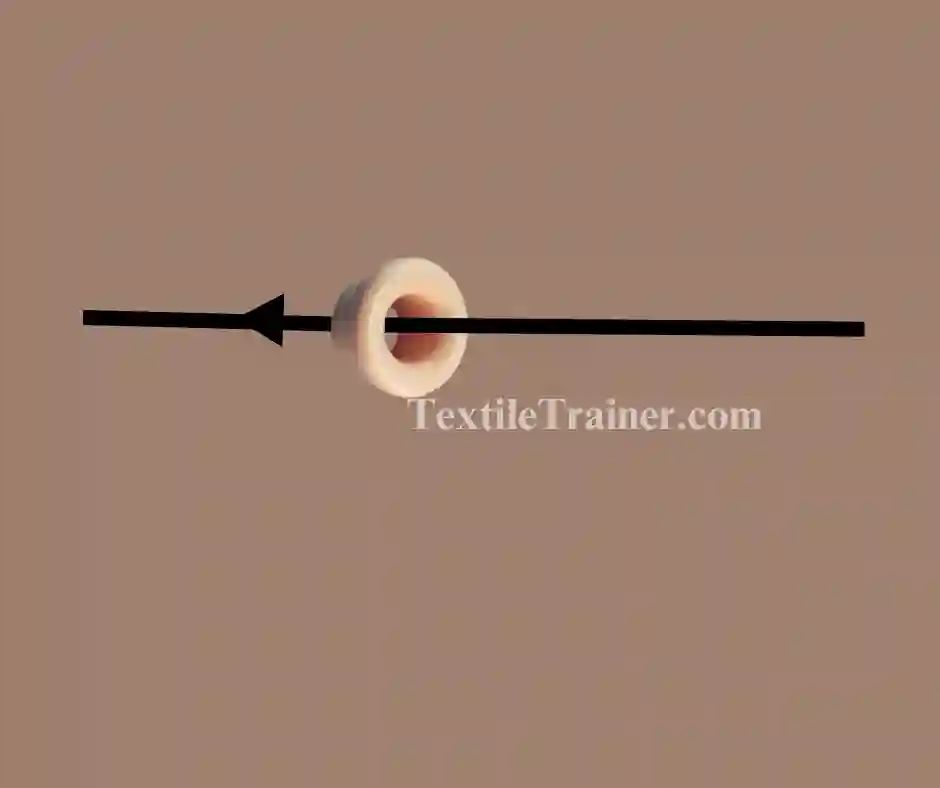
Trumpet type guide:
A trumpet guide is a specific type of guide that is commonly used in textile manufacturing processes. It is called a “trumpet” guide because of its shape, which resembles a musical instrument. The trumpet thread guide consists of a cylindrical body with a tapered, funnel-shaped opening at one end. The yarn is threaded through the narrow end of the guide, and the wider end is positioned facing the direction of the yarn’s travel. The trumpet guide’s shape helps reduce the tension on the yarn and prevent snags or breaks during the manufacturing process.
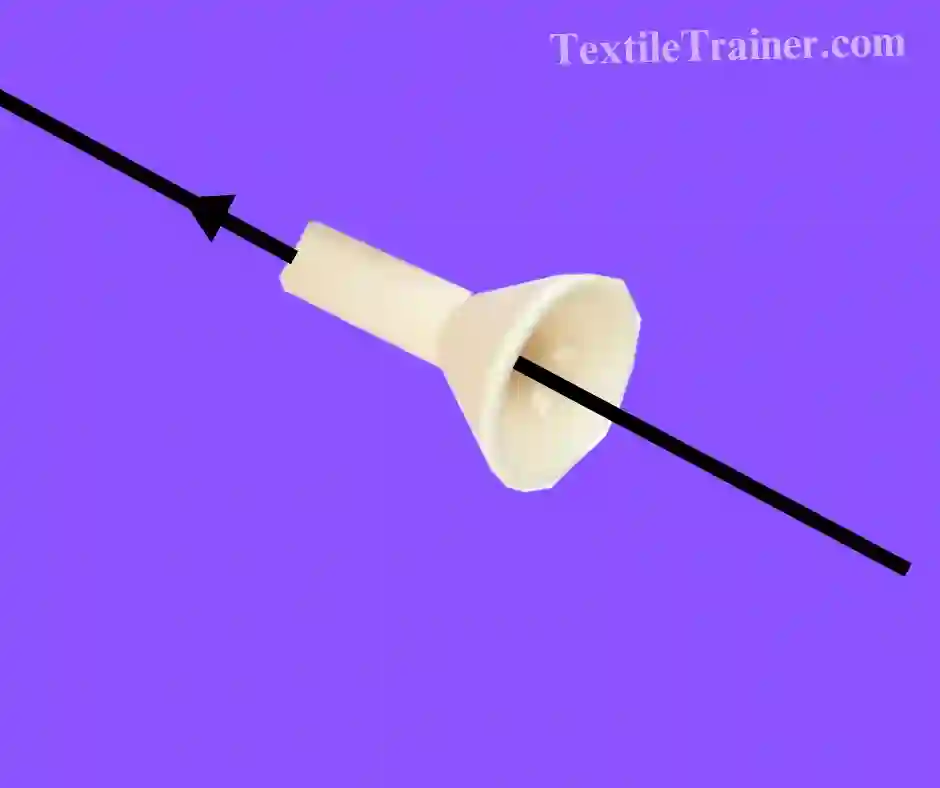
Bush type yarn guide:
Bush-type yarn guides are a specific type of guide that is commonly used in textile manufacturing processes. They consist of a small, cylindrical bush that is mounted onto a holder or bracket. The yarn is threaded through the brush’s centre, which helps guide it through the manufacturing process. Bush-type thread guides are typically made from a hard, durable material such as ceramic, tungsten carbide, or stainless steel. The choice of material depends on the specific needs of the manufacturing process, the type of yarn being used, and the conditions under which the equipment operates.

Advantage of Closed Yarn Guides
- Prevents snarling and twisting of the yarn: The closed design of the guide prevents the yarn from snarling and twisting, which can lead to breakages and other problems during the manufacturing process.
- Better tension control: The closed design allows for better control of the tension on the yarn, which helps to ensure consistent and high-quality output.
- Suitable for high-speed processes: Closed thread guides are well-suited for high-speed processes, as they can guide the thread through the manufacturing equipment quickly and efficiently.
Disadvantage of Closed Guides
- More susceptible to wear and tear: Closed thread guides can be more susceptible to wear and tear over time, especially if they are used with abrasive or high-tension yarns. This can lead to a shorter lifespan and the need for more frequent replacements.
- More difficult to clean: The closed design of the guide can make it more difficult to clean, which can lead to contamination and other issues in the manufacturing process.
- Limited flexibility: Closed thread guides are less flexible than other types of guides, which can make it more difficult to guide the thread through complex or irregular paths in the manufacturing equipment.
2. Type-B: Opened Yarn Guides:
An open yarn guide is a type of yarn guide used in textile manufacturing equipment that helps to guide the yarn through the manufacturing process. Unlike a closed yarn guide, which encloses the yarn as it is fed through the guide, an open yarn guide has a gap or opening through which the yarn passes. Open yarn guides are commonly used in low-speed textile manufacturing processes, such as in producing cotton, wool, or other natural fibers. They are often made from materials that are resistant to wear and tear, such as ceramic or hardened steel, to withstand the friction generated during the manufacturing process.
Opened yarn guides may classified into three. they are:
Pig Tail Opened Yarn Guide
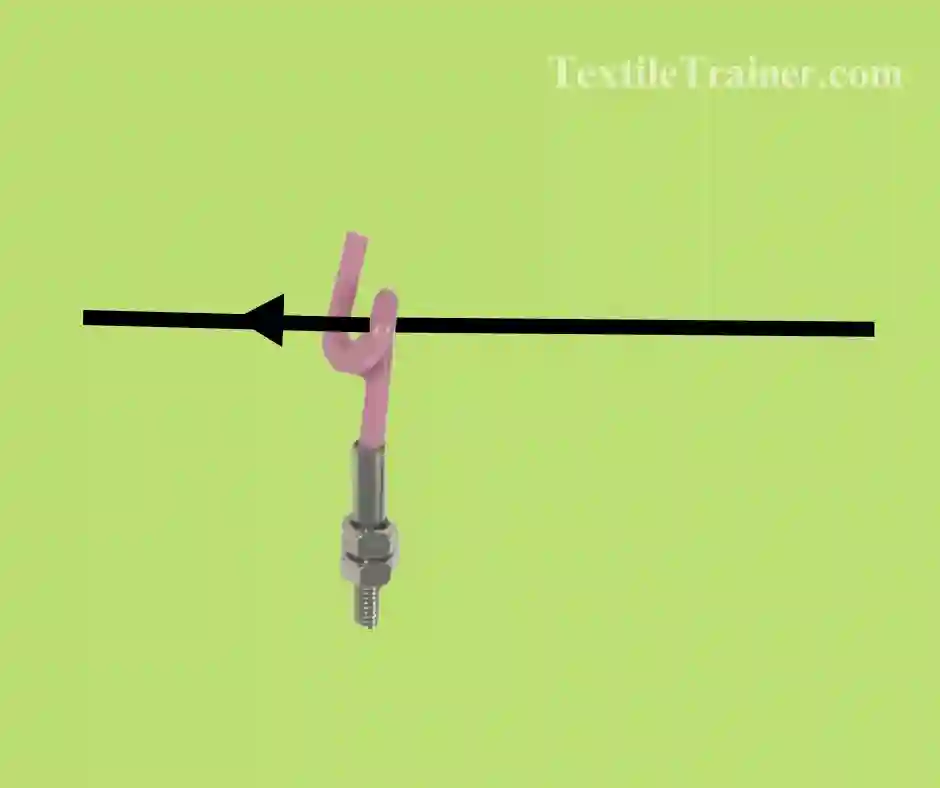
Slotted Type Guide
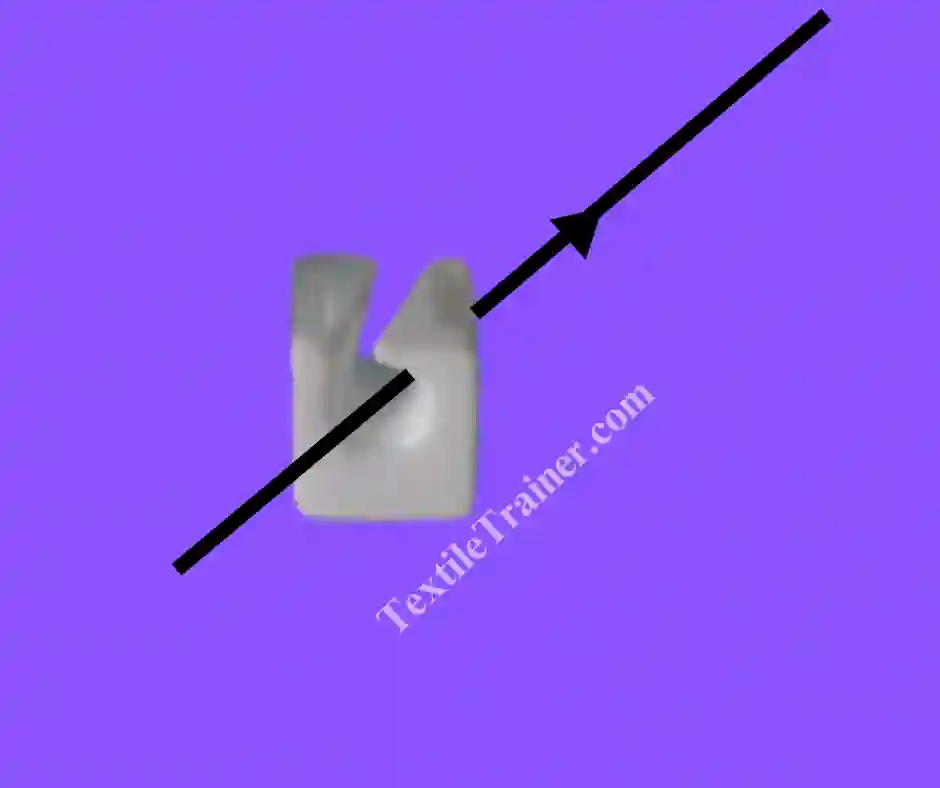
Post Type Yarn Guide
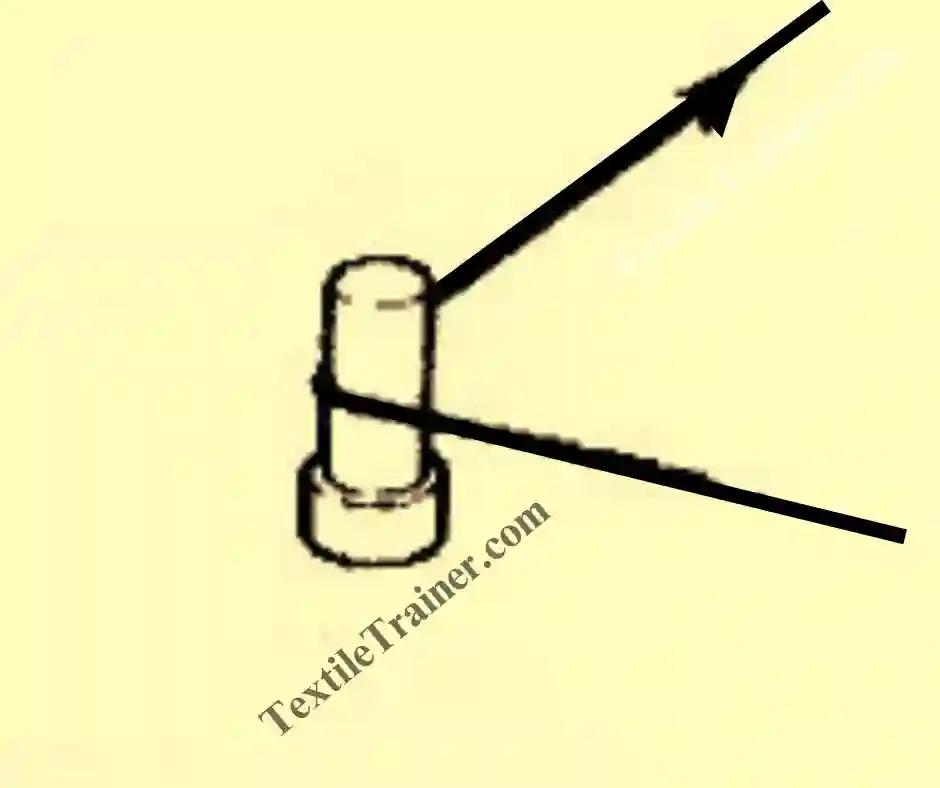
Advantage of Closed Guides
- Easy to clean: The open design of the guide makes it easier to clean and maintain, which can help to prevent contamination and other issues in the manufacturing process.
- Flexible: Open thread guides are more flexible than closed guides, which makes them well-suited for guiding yarn through complex or irregular paths in the manufacturing equipment.
- Longer lifespan: Open thrad guides can have a longer lifespan than closed guides, as they are less susceptible to wear and tear over time.
Disadvantage of Closed Guides
- Risk of snarling and twisting: The open design of the guide can increase the risk of the thread snarling or twisting, which can lead to breakages and other problems during the manufacturing process.
- Limited tension control: The open design of the guide can make it more difficult to control the tension on the yarn, which can lead to inconsistent output.
- May not be suitable for high-speed processes: Open thread guides may not be as well-suited for high-speed processes as closed guides, as they may not be able to guide the thread through the manufacturing equipment as quickly and efficiently.
Finally we can say, yarn guides play a crucial role in the textile manufacturing process. They help to guide the thread through the machinery, ensuring it is appropriately tensioned and controlled. Each type of thread guide has its advantages and disadvantages and is suitable for different applications.
You may read
- Most 10 Common Faults in Warping and its Effective Remedies
- Essential Components of warping machine and Their Functions
- Most 25 Yarn Winding Defects and Effective Solution
- Yarn Withdrawal in Weaving: Types, Advantage & Disadvantage
- Exploring Tension Device and Its Effect in Fabric Production
- Traversing Mechanism in Yarn winding is Explain Simple Way
- Best 15 Differences Between Precision and Non Precision Winding
- Types of Selvage of Fabric is Explained Easy Way



